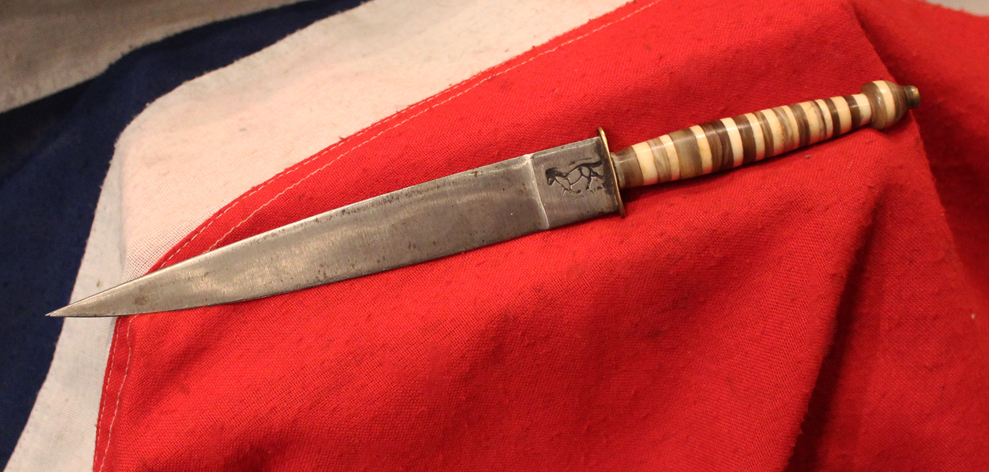South American 19th Century Brazilian ‘Faca De Ponta’ Fighting Knife Rare Antique Brazilian Cangaceiros Faca De Ponta Lampiao Bandit Dagger Knife.
Intersperced discs of carved bone and horn handle. Good maker mark logo of a prancing pony. Although made earlier they are now called after the early 20th century bandit leader. Lampiao became associated with an established bandit leader, Sebastiao Pereira. After only a few months of operating together, in 1922, Pereira decided to retire from banditry; he moved to the State of Goias and lived there peacefully into advanced old age. Lampiao then took over leadership of the remnants of Pereira's band. For the next 16 years, he led his band of cangaceiros, which varied greatly in number from around a dozen to up to a hundred, in a career of large-scale banditry through seven states of the Brazilian Northeast.
Depending on the terrain and other conditions, the bandits operated either on horseback or on foot. They were heavily armed, and wore leather outfits, including hats, jackets, sandals, ammunition belts, and trousers, to protect them from the thorns of the caatinga, the dry shrub and brushwood typical of the dry hinterland of Brazil's Northeast. The police and soldiers stationed in the backlands often dressed in an identical manner; on more than one occasion Lampiao impersonated a police officer, especially when moving into a new area of operations, in order to gain information.
The firearms and ammunition of the cangaceiros were mostly stolen, or acquired by bribery, from the police and paramilitary units and consisted of Mauser military rifles and a variety of small arms including Winchester rifles, revolvers and the prized Luger and Mauser semi-automatic pistols.
A strange and contradictory piety ran through Lampiao's psyche: while robbing and killing people, he also prayed regularly and reverenced the Church and priests. He wore many religious symbols on his person; presumably, he invested them with talismanic qualities. Like many others in the region he particularly revered Padre Cicero, the charismatic priest of Juazeiro. He was noted for his loyalty to those he befriended or to whom he owed a debt of gratitude. He generously rewarded his followers and those of the population who shielded or materially helped him (coiteros), and he was entirely reliable if he gave his word of honour. Lampiao was capable of acts of mercy and even charity, however, he systematically used terror to achieve his own survival. His enmity, once aroused, was implacable and he killed many people merely because they had an association with someone who had displeased him. He is recorded as having said "If you have to kill, kill quickly. But for me killing a thousand is just like killing one". For the cangaceiros murder was not only casual, they took pride in their efficiency in killing. They were excellent shots and were skilled in the use of long, narrow knives (nicknamed peixeiras - "fish-filleters") which could be used to dispatch a man quickly.
Lampiao's band attacked small towns and farms in seven states, took hostages for ransom, extorted money by threats of violence, tortured, fire-branded, and maimed; it has been claimed that they killed over 1,000 people and 5,000 head of cattle and raped over 200 women. The band fought the police over 200 times and Lampiao was wounded six times. 11 inches long overall
No scabbard
Code: 20875
340.00 GBP





